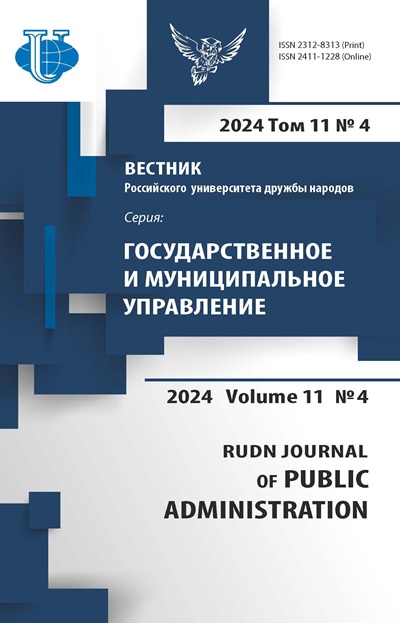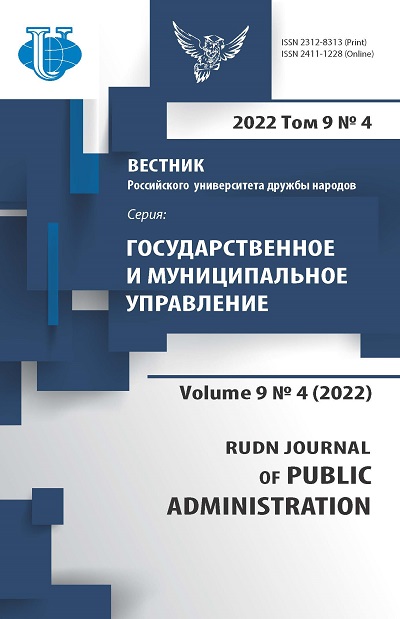Vol 9, No 4 (2022)
- Year: 2022
- Articles: 11
- URL: https://journals.rudn.ru/public-administration/issue/view/1612
- DOI: https://doi.org/10.22363/2312-8313-2022-9-4
Full Issue
THE FOUNDATIONS OF THE RUSSIAN STATEHOOD: POLITICAL AND GOVERNMENTAL ANALYSIS
Russian Statehood: Contemporary Political Views
Abstract
The demand for the study of Russian statehood is determined by the factors of further national state building. The article demonstrates the breadth of views and the range of discussion topics related to the transformation of statehood using specific combinations of existing statehood, principles, and rules for the exercise of sovereignty. The authors analyze examples of ambiguity and inconsistency of opinions about statehood as a phenomenon. The article identifies the main vectors for determining and clarifying the future positions and essences of Russian statehood in each historical period.
 351-359
351-359
 585
585
Pedigreed Legends as a Way of Integration of the Political Elite in the XVI Century
Abstract
The article analyzes the role of pedigreed legends in the formation of political and managerial elites in Russia of the XVI century. The need to recruit, circulate and consolidate the elites at that time led to the formation of the institution of pedigree legends, which allowed the nobility to lengthen and elevate their origin. The article analyzes the pedigree of the legend about the origin of the Ratsha from which many noble families had their origin. The authors conclude that the supreme power actively used pedigreed legends in its symbolic policy.
 360-368
360-368


The Main Subjects of the Formation and Development of Russian Statehood in the Late XIII - Early XIV Centuries
Abstract
The article discusses the main subjects of the formation of a unified ancient Russian state at the end of the 13th - beginning of the 14th centuries and analyzes the key factors that influenced this process. Special attention is paid to the description of the methods and tools used by ancient Russian governors in creating a unified state. The topic is relevant due to the current public and state demand for the search for new effective methods and models of governance that can be used in modern realities to build a unified and strong Russian state capable of pursuing a consistent and independent policy aimed at protection of national interests.
 369-383
369-383


Content Analysis Within the Framework of a Network Approach to the Study of the Foundations of Russian Statehood in the pre-Romanov Period
Abstract
This article presents to the reader’s a part of the results of a comprehensive study of the foundations of Russian statehood using a network approach, including the use of content analysis to overcome the limitations of the concept of political networks as a meso-level concept. The purpose of the article is to review the method and methodology of content analysis in the context of applying the network approach to the study of the formation of Russian statehood in the pre-Roman era. In addition to justifying the use of content analysis, modern software, its capabilities and methods of work are considered. Based on the data provided, conclusions are drawn about the possibility of effective use of content analysis as an additional tool for collecting and forming a database for further building network models. In our opinion, the material of the article can also be useful to a wide range of researchers who plan to use content analysis in studies of the state and society.
 384-390
384-390


CURRENT PROBLEMS OF PUBLIC ADMINISTRATION
Regional Management Centers as a New Form of Management Activity
Abstract
The article explores a little-studied topic about the modern form of regional governance based on interdepartmental communication. On the example of the Regional Management Centers (RMC) as a modern form of communication among different departments and of an informational interaction among citizens and authorities, the authors analyze the ways of forming a new public management concept, based on actors-network concept and digitalization ethics, the analysis of social networks, the concept of figuration and the fractal evolutionary concept. The authors assume that the introduction of mechanisms of an online interaction and networking creates proactive connections between citizens and authorities and increases the level of confidence and the management efficiency. The empirical data were collected through a range of interviews with representatives of different departments directly linked with the RMC activity, as well as through the documents analysis and descriptive statistics. As a result of the study, the authors draw conclusions about the importance of a network approach in the organization of public administration, where the SDGs can become a full-fledged tool as part of the new paradigm of New Public Government (NPG). At the same time, the important goals are both increasing the level of digital maturity of the population and the readiness of the system itself for restructuring at all levels.
 391-400
391-400


Features of Formation of National Innovation Systems in Different Countries
Abstract
The article examines the factors and features of the formation of the national innovation system (NIS). The subject of the study is the specifics of the national innovation system in different countries. The absence of a universal effective NIS model that is universal for all countries indicates the significance of this study. The result of the study is to identify the features of the formation of NIS for a number of countries (clusters), and recommendations for building an effective NIS in Russia. The article applies the methods of correlation and regression analysis of innovative indicators for countries for which data are available in the public domain were used. Evaluation and verification of the adequacy of the applied model is determined by numerical analysis of the data obtained, as well as by economic interpretation. Correlation and regression analysis are performed separately for countries from different clusters in order to identify features between them. The study revealed the links between the type of government, state involvement and high-tech production (innovation).
 401-417
401-417


INTERNATIONAL EXPERIENCE OF PUBLIC ADMINISTRATION
Enhancing Public Service Delivery in a VUCA Environment in South Africa: A Literature Review
Abstract
There is widespread consensus that the volatility, uncertainty, complexity, and ambiguity (VUCA) environment has contributed to the subpar quality of public sector service delivery in South Africa. Hence, the aim of this paper is to ascertain how the South African government can enhance service delivery in a VUCA world. This article presents a comprehensive study of a number of secondary literature sources. The author makes an effort to draw attention to knowledge gaps that might serve as the foundation for more research in the future. The main finding is that for the South African government to provide good service in a VUCA environment, its employees must be proficient in Results-Based Monitoring and Evaluation, Strategic Planning, Programme and Project Management Methodology, and Change Management Methodology. There is a severe lack of empirical study on the delivery of public sector services in an environment characterized by VUCA. As a result, there is a need for more research on this topic. Specifically, in order to establish the effect that the VUCA environment has on the governments of emerging nations. The research will be beneficial to the governments of developing countries, notably South Africa, as well as to those who work in the field of public administration.
 418-437
418-437


Social Networks as a Challenge to Vietnam’s Political Stability
Abstract
The authors of the article identify new types of threats caused by the penetration of social networks into Vietnamese society. The authors assess the limits of the impact of crossborder IT communications on the political stability of the state. The article analyzes the content of ideological opponents of the authorities in Facebook, Instagram, Zala, YouTube, (On March 21, 2022, the Tverskoy District Court of Moscow satisfied a lawsuit filed by the Prosecutor General’s Office of the Russian Federation and recognized the activity of the social networks Instagram and Facebook, owned by Meta, as extremist, banning its operation in Russia), search engines and other communication channels. They also share some considerations regarding the organization of counteraction to the conductors of “color revolutions”, masters of network provocations, psychological and ideological sabotage in the Vietnamese and global information space.
 438-455
438-455


Renewable Energy Sources and the Government Strategy for Developing Energy Sector in Jordan
Abstract
Energy and energy security are strategic goals for various countries of the world because energy is an important component of life. As the energy problem is gradually aggravating worldwide, especially with the increasing demand for it by a large percentage, and it is expected that these percentages will rise significantly during the coming period because of population growth and the significant increase in the number of various industrial and service establishments. Currently, most countries are seeking to rationalize in energy consumption, and to search for alternatives to energy sources. Hence, there is a keen interest in energy sources and their alternatives. In this study, energy sources and their alternatives in Jordan were identified in order to get an adequate idea of w hat is available in Jordan from this area. Jordan is one of the poor countries in traditional energy sources, and one of the countries most affected by the high prices and the shortage in the production of crude oil and other energy components, and its negative repercussions on the Jordanian economy, as Jordan imports oil and natural gas from neighboring countries 90 % of its needs Energy, which is approximately 8 %-10 % of GDP. This study attempts to shed light on the existing energy sources in Jordan with the aim of exploring ways to improve the energy situation in the country by increasing reliance on renewable energy alternatives such as wind and solar energy instead of relying on imported oil and gas.
 456-465
456-465


Using an Integrated Territorial Approach in the National Concept of Spatial Regional Development (on the Example of the Republic of Bulgaria)
Abstract
The article considers the concept of spatial regional development in the Republic of Bulgaria for the period 2013-2025. and plans for the integrated development of municipalities for the period 2021-2027, as well as current challenges that the country faces in implementing an integrated territorial approach. In modern conditions, stable economic development cannot be achieved without an effectively functioning system of regional development and improvement. The goals and plans of the Integrated Development of Municipalities should be consistent with the goals presented in the Integrated Territorial Development Strategy. The guidelines for IMDP issued by the Ministry of Regional Development and Improvement of the Republic of Bulgaria should further clearly indicate the implementation of the partnership and be sure to be consistent with the planning documents of the country’s higher level of regional development.
 466-474
466-474


Nigeria’s Poverty Reduction Scheme: Spreading Herself Too Thin?
Abstract
The Nigerian government expects to effectively pull 100 million Nigerians out of poverty by 2030. Without a doubt, the government was compelled to intervene because of the country’s severe poverty, as seen by the large number of out-of-school children, gender-based difficulties, and the residents’ pitiful socioeconomic realities. And, in order to get out of these mudslides, the government decided it was time to create a plan capable of resolving these concerns in less than a decade. However, tracing the Nigerian government’s track record of developmental failure, misplaced priorities, hasty policy formulation, and poor policy implementation that have remained recurrent feral flaws in the system, the paper expresses a cynical view about the plan’s realization; relying on historical accounts of vision failures and the country’s economic realities, it sees the scheme as an overzealous project taken too far and submits that it will be nothing different from the failed visions of the past.
 475-489
475-489
















